Microsoft Surface Pro 3 Review
by Anand Lal Shimpi on June 23, 2014 3:55 AM ESTBattery Life
Microsoft made no sacrifice in battery capacity in pursuit of Surface Pro 3's thin chassis design. The new tablet features an integrated 42Wh battery just like the previous two models. Charging duties are handled by an external 31W charger with a brand new magnetic connector. Microsoft never seemed to get a good MagSafe clone working in the previous models, so Surface Pro 3 abandons the previous design entirely in favor of something a bit more sensible.
The new connector no longer looks like an oversized MagSafe connector, and instead features a thin plastic insert that mates with the charge port on Surface Pro 3. Charge time hasn't changed, you can fully charge the device in around 2.62 hours:
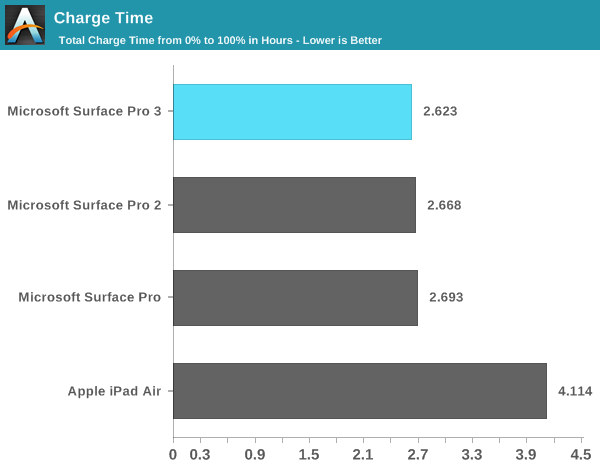
The device-side connector features 40 pins but you only need 12 of them to charge the device. The remaining pins are used for Gigabit Ethernet, USB, DisplayPort (up to 4096 x 2304) and audio. Microsoft seems hell bent on avoiding Thunderbolt at all costs so instead of embracing the standard it has created a custom alternative of its own doing. The benefit to Microsoft's connector is it can obviously deliver more power than Thunderbolt can, the downside is that it can't send PCIe and thus you don't get support for any ultra high bandwidth external storage devices. I still would rather see Microsoft implement Thunderbolt as there's at least an existing ecosystem built around that but here we are three generations into Surface and if we haven't seen it by now I don't think we're ever going to.
The supplied power adapter includes a USB charge port capable of delivering 1A at 5V.
As Surface Pro 3 is designed to be both a laptop and a tablet I've run it through both our Windows laptop battery life tests and our tablet battery life tests.
Laptop Battery Life
As a laptop, Surface Pro 3 delivers comparable battery life to other optimized Haswell ULT designs. I threw in Sony's Vaio Pro 13 into the mix because it has a similar sized battery (37Wh vs. 42Wh) and is one of the most power efficient Windows Ultrabook platforms on the market. Surface Pro 3 manages to deliver similar battery life, which means it's a little less power efficient but the two are within the same range at least.
Compared to Surface Pro 1 and 2, Surface Pro 3 at worst delivers similar battery life and at best increases range on a single charge by up to 20%. We're looking at 3.75 hours - 7.6 hours of notebook usage on a single charge depending on usage.
It's worth noting that there's a substantial advantage in battery life if we look at the 13-inch MacBook Air running OS X. I only mention this because of Microsoft's insistence on comparing Surface Pro 3 to Apple's popular line of notebooks.
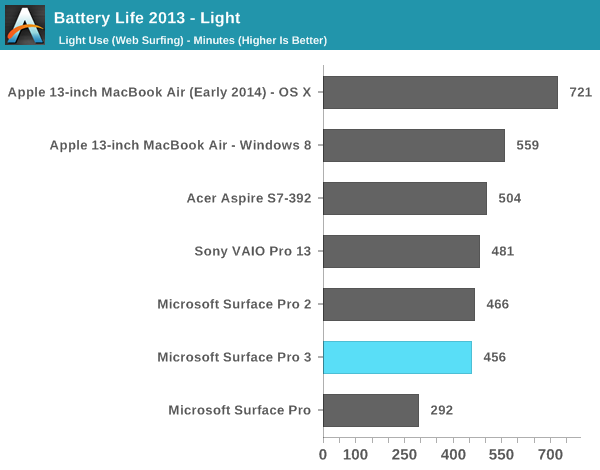

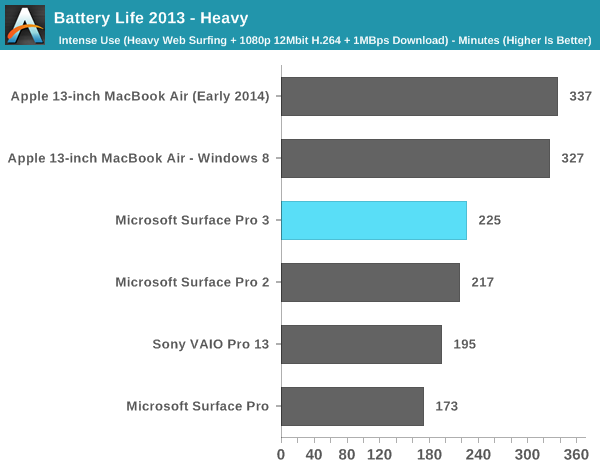
Tablet Battery Life
Tablet workloads are going to be far more display power bound than anything else. Here we see 7.58 - 8.03 hours of continuous usage, a slight regression compared to Surface Pro 2. Video playback remains more power hungry than web browsing, which is something I've noted in previous tablet-evaluations of Intel's Core silicon. I don't believe Intel's Core processors are very optimized for video decode power consumption. If anything is going to change with the move to Broadwell and Core M I suspect video decode power may be it.
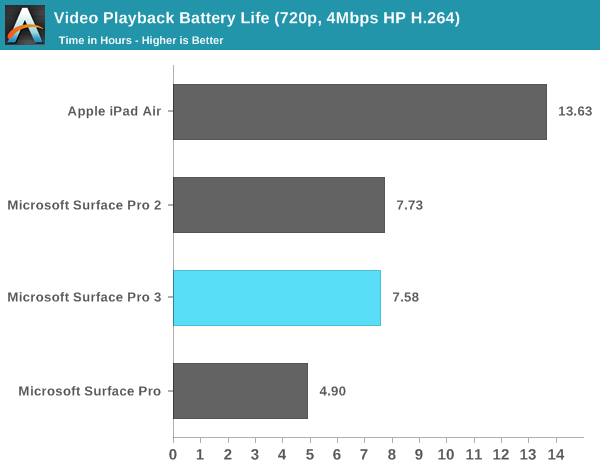
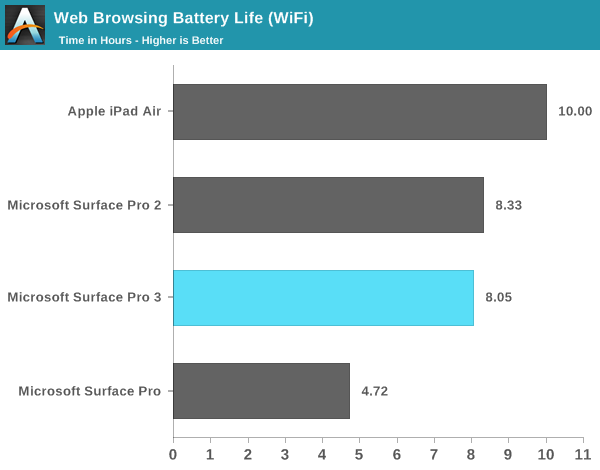


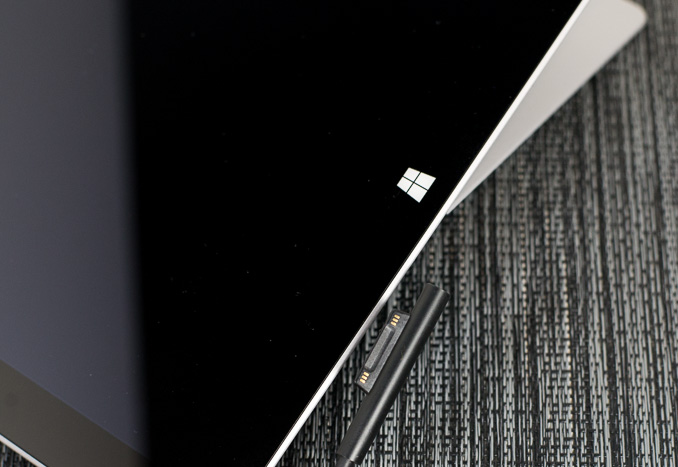
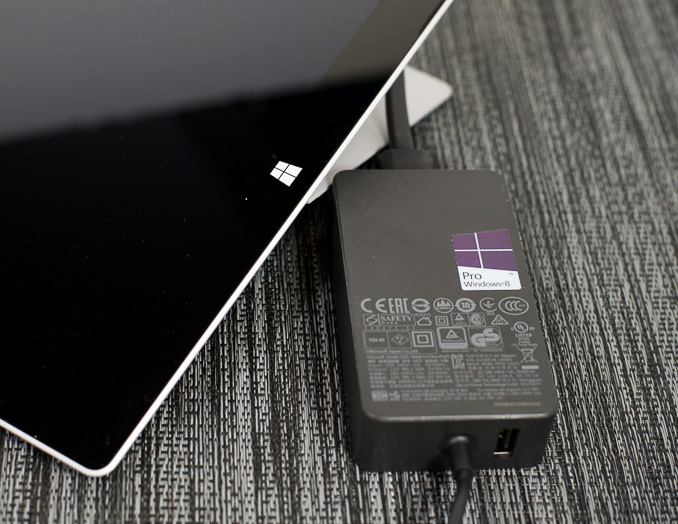








274 Comments
View All Comments
Drumsticks - Monday, June 23, 2014 - link
Heavier isn't a bad thing. The SP pen is light in my opinion, I've yet to see somebody say the pen was uncomfortable. Again, on the pen, from above:"Overall I have to say the new pen is an improvement. You get a much thinner display, an unnoticeable impact to pressure sensitivity, improved latency and the experiential improvements are substantial (one click wake/OneNote launch is useful)."
I'm not saying this as an artist. But as a user, note taking (which is my primary thing as a college student) seems to be improved.
Upgrade the GPU to what? They weren't going to get dedicated graphics in here, and the i7 model uses an HD5000. The throttling is meh, as Anand again mentioned.
I'm not saying it's perfect. I want this with Broadwell, badly. But it's a big improvement. It's not like it's going to be lacking for performance for what it's needed for. I don't expect mobile gaming out of this device, and that's the only time it really saw throttling.
ymcpa - Monday, June 23, 2014 - link
Most reviews praised the pen for being heavier and more comfortable to hold than the original pen. Gabe from penny arcade never mentioned that the N-Trig was less accurate. I will take an artist opinion over yours. I have read several reviews where it was stated that the Wacom digitizer in the pro 2 wasn't very accurate near the edges.mkozakewich - Monday, June 30, 2014 - link
As someone who's suffering with the edges of my Pro, I'd like to hear about how the NTrig handles around the edges. As it's a different technology and doesn't rely on something behind the screen, I don't think there'll be any problems.Imaginer - Tuesday, June 24, 2014 - link
As an artist, and someone who regularly uses OneNote for notes on a previous Surface Pro 2, and after using a Surface Pro 3...With Wacom pens, they are hefty like a light pencil, and handle as such. The N-Trig pen of the Surface Pro 3, feels like a quality solid inking pen in weight.
The time measured lag, is for long, prolonged strokes of quick length, instead of short and slow velocity movements. Most of the time, in writing, one isn't writing in big letters. The only time this MAY come up, is one doing quick, very long lines of strokes. Most of the time in drawing, such strokes are not too often and few in between in sketching and painting.
My only gripe, is that with the default Pro 2's pen, is that the eraser end is pressure sensitive as well, and can be flipped to erase. The Pro 3's pen, uses a second button on the side for erasing, which isn't as comfortable for me, and an adjustment of such. Here is hoping a second more "pencil" like pen that has a pressure eraser end is released. (along with lack of Wacom's radial like menu).
In the forums, I made an image showing handwriting aspects of pen comparisons - something that I felt would be a nice touch in the pen mentions - as it is not hard to pull a comparison between the two.
ymcpa - Monday, June 23, 2014 - link
This was explained by Microsoft. A human can't possibly replicate 1028 points of pressure. They can't even replicate the 256 points that the N-trig has. It's really about the pressure curve that they use. Microsoft said they will have an update that will allow users to alter the pressure curve to fit their usage.basroil - Tuesday, June 24, 2014 - link
No, Microsoft explained that even though Wacom's pen supports 1024bit, the actual useful resolution is much smaller because of how the pressure curve is set up (it's linear rather than semi-exponential like the n-trig)basroil - Tuesday, June 24, 2014 - link
1024 levels (10bit), not 1024bit (which would be a ridiculous number)ymcpa - Tuesday, June 24, 2014 - link
They talked about the pressure curve but the blog also mentioned that the human hand can't reproduce 1024 different levels of pressure. That is why it won't matter if the N-trig digitizer has less levels of pressure.theuglyman0war - Wednesday, June 25, 2014 - link
Even if an artist can not replicate 1024 levels of pressure in a single stroke ( wonder how u prove as much as humans are scary amazing beings at times ) An artist can easily need as much "threshold" in many stokes... Working very light where details build up in whispers. In which case 256 levels unutilized is complete hogwash.mkozakewich - Monday, June 30, 2014 - link
It's not even about what the artist touches on themselves, and more about the range. I'd like my pen to to be able to step from size 1 to size 255 in 1-step increments, in which case the sensitivity levels would work fine and I'd still have a pen with a massive brush. (Honestly, I'd probably not use 255 levels. More like 64.)